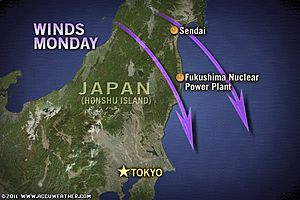Following Friday's major earthquake east of Japan, fears were raised of radiations leaks and nuclear meltdowns at power plants...
Radiation was reported to be leaking over the weekend from the Fukushima Daiichi nuclear power plant from one of the reactors that had lost its cooling system.
CNN reports that a cooling system of a second reactor at the Fukushima Daiichi nuclear power plant failed on Sunday, forcing officials to expand the evacuation zone of surrounding residents from 10 km to 20 km (6 miles to 12 miles).
Complicating matters, a second hydrogen explosion occurred at the plant early Monday.
A state of emergency was declared on Sunday at a nuclear power plant in Onagawa, Japan, as well. Excessive radiation levels have been recorded following Friday's earthquake, according to the United Nations' atomic watchdog agency.
Three reactor units at the Onagawa plant are being watched and controlled for radiation leaks and possible meltdown.
The wind direction may impact where the radiation goes both at a local level and even across the globe. The wind direction at both of these locations are similar since the Onagawa power plant is located just to the northeast of Fukushima power plant.
"The exact direction of the winds would have to be known at the time of the release of a large amount of radiation to understand exactly where the radiation would go," according to Expert Senior Global Meteorologist Jim Andrews.
It is unknown when a large release of radiation would occur, if at all, at this point.
"You can calculate how long the release of a radiation would take to cross the Pacific from Japan to the U.S. by choosing different speeds that the radioactive particles might be moving and using the direct distance between given locations- say Sendai, Japan, and Seattle, Wash.," Andrews added.
However, even that calculation may not reflect how long the particle would take to cross the Pacific, since it would not likely cross the ocean in a direct path. This is the case because the wind flow is often a complicated pattern.
A typical wind trajectory across the Pacific is westerly, since there is often a large dome of high pressure over the central Pacific and an area of low pressure in the Gulf of Alaska.
Any storm systems moving across the Pacific would add kinks in the westerly flow that would make the path of a particle crossing the Pacific longer.
"In other words, it would be a very intricate and difficult calculation," said Andrews.
On a local level, it is easier to break down the direction of the wind.
On Monday, the winds at the Fukushima power plant and the Onagawa power plant will generally be out of the north to northwest. So, the wind flow will still be directed offshore into the Pacific.
This would be a protective wind that would blow most of the radiation out to sea.
The wind direction will switch to an onshore direction Monday night into Tuesday, threatening to send the radiation toward the population.
"We are getting into the time of year where onshore winds occur most often," said Andrews.
This is not good news, since an onshore direction would blow most of the radiation toward populated areas. An added threat is that with higher elevations just about 4 miles inland from the power plants, if a temperature inversion sets up in the atmosphere, radiation could be trapped.
Authorities have warned residents to keep windows and doors closed and air-conditioning fans switched off to eliminate the intake of air from outside.
Calculated time for radioactive particles to cross the Pacific from the power plants in Japan to big West Coast cities if the particles take a direct path and move at a speed of 20 mph:
| Cities | Est. Distance (miles) | Est. Time to Cross Pacific (days) |
| Anchorage | 3,457 | 7 |
| Honolulu | 3,847 | 8 |
| Seattle | 4,792 | 10 |
| Los Angeles | 5,477 | 11 |
Source: Meghan Evans, Meteorologist



No comments:
Post a Comment